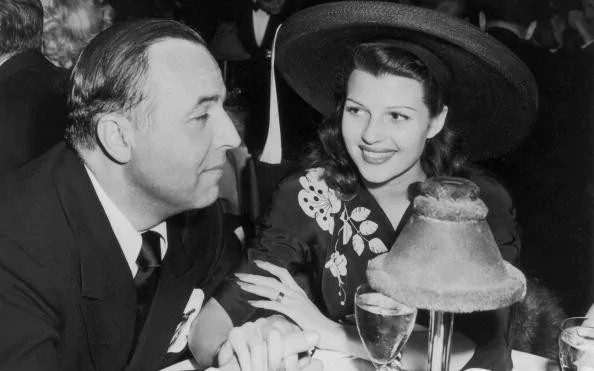The radiant beauty and undeniable talent of Rita Hayworth made her one of Hollywood’s most captivating stars. Known as the “Goddess of Love,” Hayworth was the embodiment of glamour and sensuality, gracing the silver screen in the 1940s. But beneath the glitz and adoration, her life was marred by unimaginable hardship, abuse, and sorrow. From a troubled childhood to tumultuous marriages and an eventual descent into illness, Hayworth’s story is one of resilience overshadowed by tragedy.
A Star Born into Darkness: Early Life and Childhood Trauma

Born Margarita Carmen Cansino on October 17, 1918, in Brooklyn, New York, Hayworth’s life began under difficult circumstances. Her father, Eduardo Cansino, was a Spanish flamenco dancer with high ambitions for his daughter. He pulled young Margarita out of school at the age of 12, pushing her to perform as his dance partner in The Dancing Cansinos. In sultry costumes and thick makeup, she was forced into an adult world long before she was ready. To circumvent U.S. child labor laws, Eduardo moved their performances to shady nightclubs and gambling boats, even going as far as to introduce her as his wife. These traumatic experiences in her early years would leave lasting scars.
Eduardo’s control over her life wasn’t limited to dance. Barbara Leaming’s biography on Hayworth revealed disturbing details, including allegations of abuse at the hands of her father. The physical and emotional suffering during these years deeply impacted Hayworth’s self-worth, shaping her relationships and career in ways that she couldn’t foresee.
The Hollywood Transformation: From Margarita Cansino to Rita Hayworth
In 1935, at just 16, Hayworth caught the eye of a Fox studio producer while dancing in Agua Caliente, Mexico. This chance encounter opened the door to a Hollywood career, albeit with a new persona. To fit the industry’s standards, she underwent a complete transformation, shedding her Spanish roots to become the all-American beauty, Rita Hayworth. She dyed her naturally black hair a rich auburn, raised her hairline through painful electrolysis, and adopted a new name and identity that would make her one of Hollywood’s most iconic stars.
Yet, this transformation came at a cost. Her first husband, Edward Charles Judson, a 41-year-old car salesman who marketed himself as a wealthy Texan, became her manager. Judson saw her not as a person but as an “investment” and often resorted to manipulative tactics to advance her career. He forced her into cosmetic changes and aggressively marketed her image, reportedly even offering her to powerful studio executives to secure roles. Hayworth’s marriage to Judson was not only emotionally abusive but financially exploitative, with Judson collecting a large portion of her earnings. It wasn’t until 1942 that she found the strength to leave him, though the damage left her wary and wounded.
Rise to Stardom and the Iconic Gilda
In 1941, after gaining modest success, Hayworth signed with Columbia Pictures, where studio head Harry Cohn saw her potential. He cast her in roles that leveraged her alluring persona, including her breakthrough performance in Only Angels Have Wings (1939) opposite Cary Grant. She soon became one of Hollywood’s most desirable actresses, landing high-profile roles alongside stars like Fred Astaire in You’ll Never Get Rich and Tyrone Power in Blood and Sand.

Her iconic portrayal of Gilda in the 1946 film Gilda solidified her place in Hollywood history. With her sultry performance as the seductive and troubled Gilda Mundson Farrell, Hayworth captivated audiences, earning her the title of “Goddess of Love.” Ironically, while Gilda represented the ultimate symbol of desire and confidence, Hayworth herself struggled with self-doubt and disillusionment.
The role was both a blessing and a curse. Hayworth later admitted that the character of Gilda haunted her, casting a shadow over her career and personal life. She felt trapped by Hollywood’s expectations, confessing, “The men I know are all crazy about Gilda, but I’m just bothered.” Despite her frustration, Gilda cemented her legacy as one of Hollywood’s most enduring sex symbols.
A String of Marriages and Broken Dreams
While Hayworth’s on-screen success skyrocketed, her personal life was marked by a series of turbulent and painful marriages, each adding another chapter to her tragic story.

- Edward Charles Judson: Judson’s manipulation and exploitation left Hayworth emotionally scarred, and their marriage ended when she finally found the courage to seek a divorce.
- Orson Welles: Shortly after her first divorce, Hayworth married the charismatic filmmaker Orson Welles. Their relationship began with hope and excitement, producing a daughter, Rebecca. However, Welles’ controlling nature and infidelity soon eroded their bond. Despite a brief attempt to salvage their marriage by co-starring in The Lady from Shanghai (1947), they divorced in 1947. Welles later admitted that Hayworth was one of the kindest women he’d ever known, though they couldn’t find lasting happiness together.
- Prince Aly Khan: Hayworth’s marriage to the wealthy playboy Prince Aly Khan was a glamorous affair that turned out to be another disappointment. After the birth of their daughter, Princess Yasmin, the couple’s differences became increasingly apparent. Khan’s infidelities and lavish lifestyle left Hayworth feeling isolated and unfulfilled, leading to a divorce in 1953.
- Dick Haymes: Hayworth’s fourth marriage, to singer Dick Haymes, was perhaps her most tumultuous. Haymes, known for his heavy drinking and volatile behavior, subjected Hayworth to both emotional and physical abuse. This union left her financially drained, and after one particularly violent incident in public, she sought refuge and filed for divorce.
- James Hill: Her final marriage was to director James Hill, with whom she hoped to find stability. Though they initially bonded over their shared love of film, their relationship soon turned sour. The couple endured numerous arguments and eventually divorced in 1961, marking the end of Hayworth’s hope for a loving and supportive partner.
Each of these marriages left Hayworth more disillusioned, yet she remained resilient, continuing to work and support her children despite the personal toll.
The Slow Descent: Struggles with Fame and Final Years

By the late 1950s, Hayworth’s career began to wane. Though she attempted to revive her image in films like Separate Tables (1958), her declining health and struggles with alcoholism affected her performances. In the early 1960s, signs of Alzheimer’s disease began to emerge, but it went undiagnosed for many years, with many attributing her forgetfulness and mood swings to her battle with alcohol.
In 1980, Hayworth was finally diagnosed with Alzheimer’s, making her one of the first public figures to bring awareness to the disease. Her daughter Yasmin became her primary caregiver, remaining by her side during the difficult final years. Her once-glamorous life had devolved into a quiet, heartbreaking struggle, with Hayworth spending her last days in a New York City apartment far from the limelight.
Legacy of a Goddess: Remembering Rita Hayworth

Rita Hayworth’s life story is a tragic testament to the darker side of Hollywood. She achieved fame, wealth, and adoration but suffered immensely behind the scenes. In her youth, she was exploited by those closest to her, and as an adult, she was betrayed by the men she loved. Despite her pain, Hayworth remains an enduring icon, a symbol of classic Hollywood beauty and charisma. Her legacy, however, also serves as a reminder of the human cost of fame and the challenges women in Hollywood face even today.
In 1987, Hayworth passed away, leaving behind a legacy of unforgettable films and a life marked by courage and resilience. Her name remains synonymous with beauty and allure, but her story sheds light on the darker realities behind the glamour. Rita Hayworth was, indeed, Hollywood’s “Goddess of Love,” but her life was anything but a fairy tale. The image of Gilda may have immortalized her as a screen legend, but it was Margarita Carmen Cansino—the woman behind the image—who carried the weight of a life filled with struggle and hardship.


